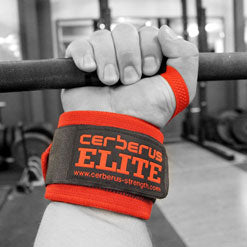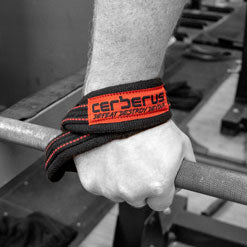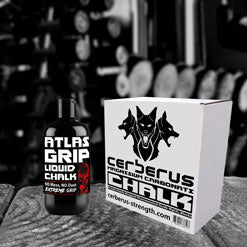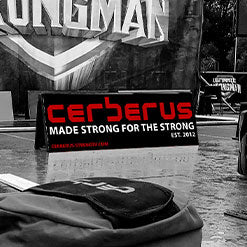Introduction
My name is Dale McPherson, I am a team Cerberus athlete, professional strength coach and top level weight class strongman 80/90/105 kg. In the past I competed at world championships in all weight categories, setting British records in log press and world records in deadlift. The most noticeable and prominent record is my title for being the first man to ever deadlift 4 x BW in the under 90kg weight class. Regarding my competition track record, I have obtained podium finishes in the Arnold classic Australia, Europe and the Arnold’s USA.
Strongman and strength training, have been a massive part of my life since I was 16 years old and have been competing now for 12 years in powerlifting, strongman and mma. When I am not competing in strength sports, I am focusing and managing my own business 3D Strength in Darlington. 3D Strength is a coaching focused business, aiding strength sports athletes in reaching their goals in training and when competing. My clientele includes athletes like Aaron page, Gavin Bilton, Pa O’Dwyer, Louis Jack, Ben Williams, Danny Weatherill and many other strength athletes in strongman and various other sports such as boxing and mma.
In this blog we will discuss the over-head press and in particular the log press. One of the most commonly used exercises in training and when competing at strongman competitions.
The brain body connection
The Brain and body are connected through neural pathways made up of neurotransmitters hormones and chemicals these pathways transmit signals between the body and brain to control our every-day functions especially when we are training certain movement patterns.
Performing in strongman requires a strong relationship between the brain and body during Training and of course competition. We need time for the brain to teach the body how to perform a specific move for it to become automatic and natural. The only way to build strength between the brain and body is through repetition and drills over a period of time across multiple sessions, this is the best way to bond the connection between the mind and body.
The ability to react to a situation in real time without the brain and the body having to waste unnecessary energy gives an athlete the ability to enter “flow state”. This requires very little thought because the body is programmed to perform a certain way! A great example are weightlifters at the very peak of their careers as their form is absolutely stunning and this is because of the practice of their forms then proceeding with repetition.
If you spend time drilling the wrong techniques or spend time drilling bad techniques into your brain this will lead to some bad habits in the brain and body connection. This requires a great deal of training to unlearn so next time you’re in a gym and you see someone doing themselves more harm than good don’t be scared to offer some advice and tips.
It has taken me years to unlearn bad habits and techniques, as such this has given me sufficient reason into producing this blog. To provide you with the necessary knowledge so in the future you won’t make the same mistakes I have in the past. I am fortune now to be regarded as one of the best strongman Coaches in the UK, so let’s get into it and create that brain and body connection.
Foot positioning
A very basic way to pin point a natural foot position for yourself is to jump in the air and see where you land and go from there. This way you can play with the position yourself, one thing to remember is when you go narrower with the feet you can generate more force through the legs compared to a wider foot position. The positive to this is with more leg drive you can get the log off your chest much quicker however you may find you’re a little more unstable at the lockout. Where-as if you go wider with the foot position you may find you can’t quite get the leg drive as much, as a result there is a high possibility that the log will come off your chest slightly slower. But with this method you will find yourself more stable in the lock out portion. For you athletes who like to split jerk unfortunately I can’t help as it’s not my strong point, so be sure to get yourself a qualified and experienced weight lifting coach as this variation is different to the general push or strict press.
Position on the handles of the log
It’s key to remember that not all logs are the same, some handles are longer than others and some are shorter. Logs can also vary in diameter but usually they’re around 13 inches give or take. You may find lighter weight classes and females might use smaller diameter logs but this isn’t always the case. I would recommend you place your hands bang in the middle of the log to clean it, why? Because it is much better for hand positioning and consistency especially on the press. But we are all different at the end of the day, I personally prefer to clean the log with my hands slightly more forwards. I find the clean to be more comfortable in this position but by doing this method I do end up hindering myself when it gets to the top; as I have to adjust my hands when it’s on my chest to get to the sweet spot to press. But as a general rule for people starting out I would recommend hands in the middle and always keep a nice tight grip on the log.
Log pick up
Stand over the log with your shins right to the log, this is the optimal position as you don’t want the log to get away from you. The further away the log is from you the weight will feel heavier and you will have to pull it towards you anyways to lap it. What I recommend to do is slightly tip the log forwards, this way once you lap the log it’s a little easier to pull the log tight to your hips and belly. Then when you do go to clean it you’re not having to fight to get your elbows under the log as much.
Remember when you stand up with the log keep, to keep it pulled nice and tight! Depending on the person (no disrespect to the big lads) if you have a power belly you can sit nice and deep into the bottom position, then position it to rest on top of your belly. Great examples of athletes who use this to their advantage are Hicksy and Luke Stoltman. From this position pull the log tight, push through your knees and hips to stand up tall get them elbows under the log and there we go.
For athletes like myself who are a little slender you may not have the luxury of the power belly. So it’s very important you find a nice sweet spot in the hole of the log pick up and really pull that log nice and tight to yourself. Make sure to always work on keeping it tight to the belly and chest, I like to say to clients think of the log as though it’s a stone; keep it tight stand tall and don’t give it any space. When you explode out of the hole keep the elbows high and tight as you stand up and extend pull tight then get the elbows under the log.
On a side note try not to do the chicken limbo with the log and bend yourself in half making the clean. Be sure to work hard on perfecting the clean and make it as energy efficient as possible. Otherwise you may find you’re going to burn yourself out before you even get to the press. So practice them cleans watch your training videos and get it nailed on.
The Clean Position
After you have cleaned the log and have it up on your chest, make sure to get your chin up as high as possible so the log sits against your throat with your head back as far as possible. This allows you to get the weight of the log over your mid foot as much as possible ready for the press. This way the weight of the log is distributed in the centre of the body, you don’t want it getting to far away from you as this can cause issues with the press. If the weight is off balance it can throw you onto your toes a little too much which will affect the line path of the press.
Breathing Technique
When you are about to break the log off the floor on the pickup, I would breathe in and brace then lap the log. Breathe out when the log is on your lap then another deep breath in and brace before cleaning the log. Hold your breath until the log is up on your chest and breathe out. Before pressing take another deep breath, brace again and press.
Alternatively you can hold your breath during the clean and press without taking another break between the two if it feels better. But there is the risk of going light headed, which can be dangerous at heavier weights. So I wouldn't recommend the second breathing technique for heavy/max lifts or log for reps events.
The Press
Once the log is stabilised on the upper chest and shoulders make sure your elbows are at 90 degrees in a solid front rack position. The last thing you need is them elbows dropping, this will distribute the weight too far forward and make the press much more difficult, particularly if you don’t have a solid front rack frame to press from. It is key you get the elbows in the right position to enable you to squeeze them tight so you can pin the shoulder blades. You are wanting the weight to sit into the shoulder blades so it feels nice and tight. However it’s important that you’re not only thinking about pressing from just the shoulders! You need to remember pressing a log isn’t like a bar, the weight is spread right across the chest and when it gets heavy it can feel like it’s smothering you. The phrase I use a lot is “weight distribution is so important” let your whole body take the weight and don’t only rely on the shoulders.
Now we have our elbows in position, keeping them nice and tight with the shoulder blades back. I like to teach people to tilt the head back but keep the eyes looking forwards; this way you won’t throw yourself off. As you dip the knees, make sure to tense your quads and glutes at the same time as your core (it’s not a squat remember it’s a tiny dip so you can generate force through the feet and not lose your line). Bring the knees out slightly so they go over your mid foot, push sharply right through the middle of your feet and explode through your big toe. Be sure to remember when you do explode and you drive through the big toe you want to be brining your heels down as fast as possible, don’t go calf raising the log otherwise you will lose power and stability. Ensure you’re always keeping your front rack position solid on the dip never let your elbows drop or your chest sink, chest must up be tall and stay solid to ensure that the legs dip and the elbows don’t!
Now we have dipped and pushed you are ready to let loose as the log leaves the chest and the line is smooth because you kept your front rack solid as a rock! We will now transition by always keeping the elbows tight (don’t be letting them little buggers flare out now all that hard work you have done to keep that upper back solid doesn’t go to waste) stay tight keep your eyes on the log, let the upper back and triceps do the work. Lock the triceps out then push your head through and there we have it you have just done a beautiful log press!
People have different views on head position and the right time to lock out, but from my own personal experience with coaching others and training myself. I find keeping the head back until the log is locked out to be a more stable position to be able to handle heavier loads. The upper back and triceps can work together to support the weight. I’ve found pushing the head through too early can cause the elbows to drift out or you can find yourself losing your line; by pushing forwards to fast and then the log can get away from you or you can find yourself fighting the press to save it.
I hope you have enjoyed this blog as strongman is a massive part of my life and I strive to help improve the sport on a daily basis. If you ever need any advice or would like to talk to me about assistance work for over-head or anything else related to strongman I am always available to talk.
Dale McPherson
3D STRENGTH
















































Thank you, this was excellent! More like this even a video would be awesome.